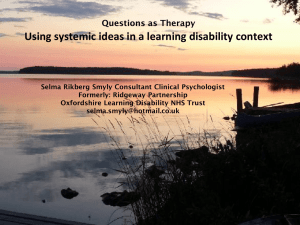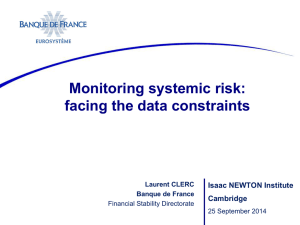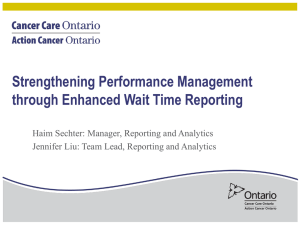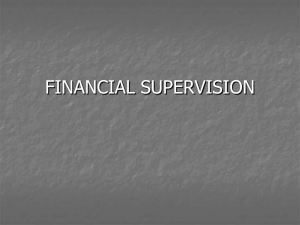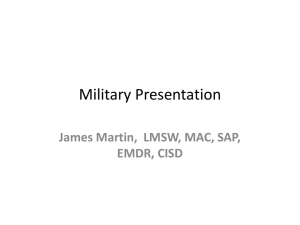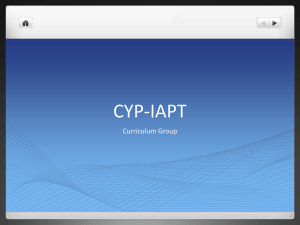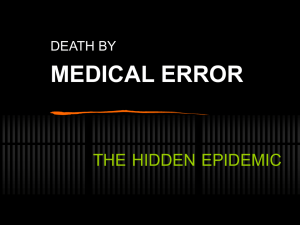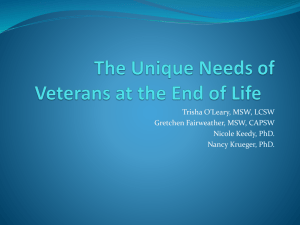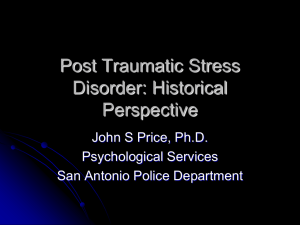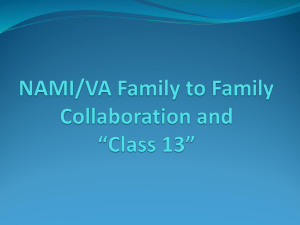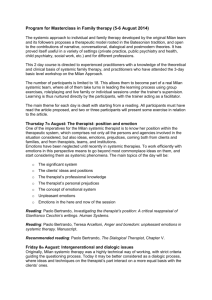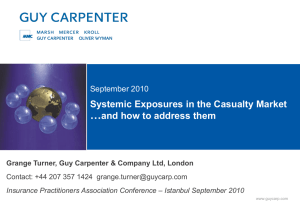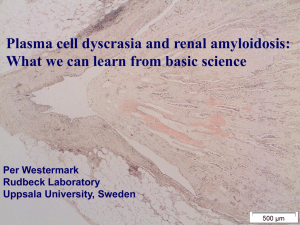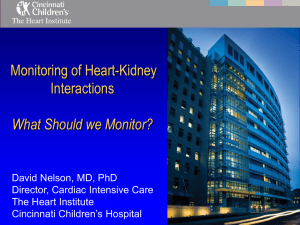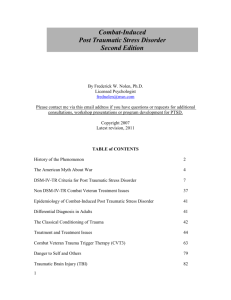Veterans, Families, & Communities Under Fire
advertisement
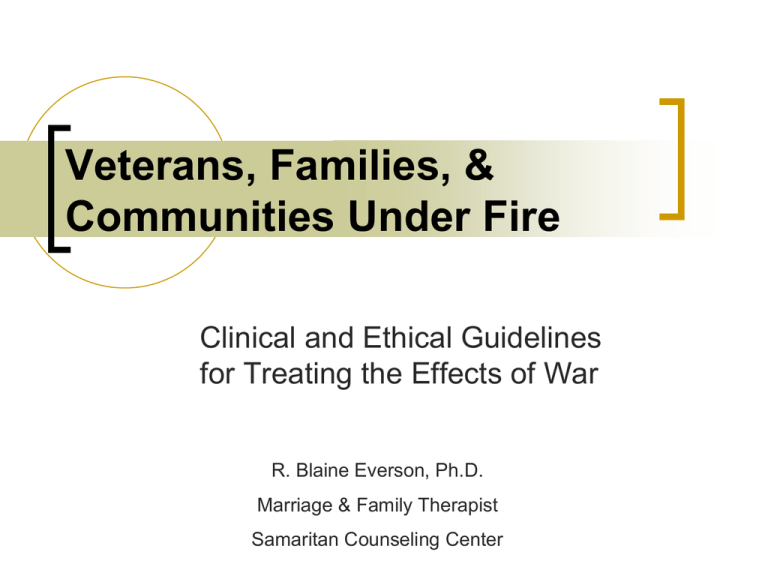
Veterans, Families, & Communities Under Fire Clinical and Ethical Guidelines for Treating the Effects of War R. Blaine Everson, Ph.D. Marriage & Family Therapist Samaritan Counseling Center Learning Objectives Learn a systems based approach to common problems seen with vets and families Better understand military culture & language upon practice & broader culture Ethics of assessing, evaluating, & treating vets & their families from a systemic perspective Utilize knowledge of indepth ethics associated with interventions where needs of vets & families may diverge. Learn more about seeking & providing supervision for working with vets & their families. Identify ways of become a more veteran friendly therapist and attracting clients. 2 Military Culture Sociologists define culture as … • Language - nomenclature; acronyms, abbr. Beliefs – defenders of Democracy Value systems – leave no one behind Norms & rules – formal & informal conduct Material products – weapons systems • • • • Associated with a social system & unique to a given system. 3 Language Barriers for Civilians MOS BNOC NTC PCS DCU AWOL LTC NCO BAH ETS FOB Type of Uniform Preparation Encampment Desert Warfare Training Moving Sergeant Staff Sergeant’s School Rent Money Leaving Without Permission Leiutenant Colonel Job in the Military Separation from Service 4 Military Cultural Influences on Society Military systems and its participants have influenced our society at-large in various ways – politics, business, etc. Language – “snafu”, “whole 9 yards”, “son of a gun”, “dressed to the 9’s”, etc. Behaviors – smoking cigarettes becomes fashionable for males after WWI b/c common in rations. 5 A Warrior Caste Military is a caste system into which marines, soldiers, sailors, & airmen are reborn as recruits via basic training & re-socialized into specific roles within the military system. Total institutions where many aspects of life are dictated and contrived via rules & regs. Then they are ritualistically baptized by combat & set apart from the rest of society for remainder of their lives due to these extraordinary experiences. A “warrior” from that point in time onward. 6 Creeds and Mottos of Military USMC Rifleman’s Creed This is my rifle. There are many like it, but this one is mine. It is my life. I must master it as I master my life. Without me, my rifle is useless. Without my rifle, I am useless. I must fire my rifle true…Before God I swear this creed. My rifle and I are the defenders of my country…and there is no enemy. 7 Military Families As Embedded Systems Service Member Military Family Service Unit/Support Military Installation Local Community National Defense System Understanding How Military Families Influence (and Are Influenced by) Multiple Systems Is A Must for Practitioners Working With this Clientele 8 Military Family Life Cycle <May be 1st deployment for both partners> -Courting -Pregnant Deploy New family begins in absentia <Missed 1st year of marriage> Mid-tour leave -Marriage Parental adj & young children Return & Reunion Resume normal routines <Divorce & remarriages w/ kids for previous relationships are common – complex stepfamily> ETS or Retire Families w/ teens & possibly steps Relocation Return & Reunion Family w/ school agers Redeploy Transitions are often marked by crisis points in the family life cycle. 9 A Dynamic Family Systems Model for Understanding Military Family Problems Changing External Environment “Withdrawal” Amplifying Info Out (+) feedback e.g. “cut-offs” Complex Adaptive Behaviors Emerging Features (Symptoms) Info In Info In (-) feedback “Re-deployment” Dampening e.g. “secrets” Info Out Changing External Environment “Therapy” Changing External Environment Changing External Environment Reactive Relational Dynamics “Misbehavior” 10 Basic Emotional Triangulation between Military Families and the Military System military service member children spous e Returning Warriors: Your Practice Uninjured or unimpaired, but with familial problems. Physically injured seen with familial problems. Psychologically injured with familial problems. Physical & psychological injuries impacting families. 12 Veterans And Families Under Fire Part II Ethical Understanding of Treatment Options & Interventions 13 A Systemic Orientation Family Structure Boundaries Family Roles & Rules Triangles Birth Order Ecosystems Family Development Lifespan Development Resilience & Vulnerability Crisis in Families Belief Systems Family Process Emotional Regression Differentiation & Separation Multigenerational Influences Paradoxical Situations Family Secrets Family Rituals Sibling Relationships Assessing Problems & Systems Treatment – Part I History taking Clinical interview Life span stage Scales & indices Genograms Mindset during assessment: willing to include military service in history taking. Multiple life cycle phases experienced simultaneously & may conflict w/ phase progression. Disruptions frequently erupt in a crisis state & must be managed by therapist. 15 Assessing Problems & Systems Treatment – Part II Genogramming Complexity!!! Unit members may be 2nd order family. Time consuming b/c of complexity Helpful for teasing out systemic issues related to step-family, FOO, etc. m. 04 m. 99 – d. 03 16 Assessing Problems & Systems Treatment – Part III Church Ecomapping is a graphical representation showing all of the systems at play in an individual's life Sometimes more helpful to focus on extra-family connections Helps understand stressors stemming from embedded nature of families Son (5) Dad Unit Mom Step-son (8) Scouts 17 Systems Oriented Therapy Should not view the family problems as simply vet’s readjustment issues (context) Family problems may have existed prior to ETS or last deployment (history) Presenting px should be viewed within larger focus of recent service (events) 18 Systems-Based Diagnosis of Common Operational Maladies Traumatic Brain Injury Combat Stress Injury Post Traumatic Stress Disorder Generalized Anxiety Disorder Panic Disorder Depressive Disorders TBI & CSI in a Systemic Context Traumatic Brain Injury Ranges from mild to severe – concussions to major intracranial trauma Concussive episodes – IED, RPG, etc. Sx include: of memory loss, poor concentration, sleep px, body aches, pain, high BP, fatigue R/O b/w mTBI & PTSD Combat Stress Injury Exposure to deployment related stressors & operations Physical, emotional & cognitive impact Sx may morph into major clinical syndrome Combat Exposure Scale is valid & reliable for assessment of CSI 20 PTSD & CSI PTSD: three symptom sets Hyperarousal – startles easily & hyper-vigilance Intrusions – flashbacks & nightmares (terrors) Constriction of affect – numbing or dissociation Combat Stress Injury: Physical hardships >noise, blasts, dirty, malnourished Cognitive > +/- information, mission ambiguity, lack of contextualizing Emotional > fear of injury or death of comrades, shame/guilt, helplessness, killing Social > social support vs. privacy issues; public opinion Spiritual > forgiving; self-forgiveness; loss of faith 21 Systemic Considerations in Stress Disorders Allostasis vs. homeostasis – equilibrium restored by shifting set point - w/ allostasis the fulcrum is moved in a particular direction disallowing the return to previous functioning Neurotransmitter-receptor hypothesis – changes due to stress & predispositions may be irreversible due to depletion of NE & 5-H serotonin in the CNS New modalities for treating stress disorders are emerging or improvement in existing methods in response to more severe & tx resistant disorders 22 Family Empowerment Therapy: Five Phase Model Beginning & Exploration of Problems Framing Problems & Balancing Ind Needs: Optimizing Therapy Environs Retelling of Events: PTSD & STS related Reframing, Altering Structure, & Healing Narrative Closure & Follow-up (p. 198-203 FUF) 23 A Paradigm for Understanding Post-War Healing Within Veteran Families Key: Solid – represent overt interactional pattern Dashed - represent covert interactional pattern The Healing Journey Secondary Disability Dynamic Spouse -Δ in communication -w/h negative info? -parentified child? - accounts for changes & transitions in family dynamics across time, situations, & stages of life (ETS, PCS, etc.) Parent-Child Relational Dynamic Spousal Disability Dynamic Couple Relational Dynamic -reduced intimacy -disengagement -poor communication Parent-Child Relational Dynamic Children Soldier Injury Φ – physical aspects -Extent of Injury -Limitations Ψ – emotional Parent-Child Disability Dynamic -reduced interaction -estrangement -negative reactions (stage dependent) -# of children The entire family dynamic changes from this point forward in time as the family attempts to accommodate the injury and adapts to new situations as they arise. Physical rehab & psychotherapy must balance emotional and physical aspects of injury with family support, while maintaining focus on the value of the family as a healing environment and attending to family member’s emotional needs to that end – all must heal together. impact 24 PTSD & Secondary Trauma: Case Illustration – Sgt. Love -PTSD -Depression -Affair -Secondary stress -ETOH Abuse -Withdrawal 37 42 46 m. 96 – d. 2002 m. 2006 -Presenting problem? 10 22 7 - Diagnosis? - Treatment plan? - Strengths? -Referrals? Genogram circa 2011 1) Lived parallel lives since Afghan Deployment. 2) Lost Battle Buddy in IED blast – injured himself. 3) Working as a foreman at a metal fabricator. 4) Difficulty talking to one another. 25 Ethical Issues Associated with Treating Veterans & Families Must balance needs of family and veteran needs simultaneously Consultation with other healthcare professionals may be needed Ethics associated with labeling vets & stigma attached to labels Working with VA resources & systems can be frustrating for private providers 26 Veterans And Families Under Fire Part III Systems Based Supervision & Being a Veteran Friendly Therapist 27 Supervision Issues Sometimes difficult to see multiple layers of systems Orient to family lifespan development perspective Differentiate relational diagnoses from individual axes Help supervisee understand triangle b/w themselves & family Help integrate systems based knowledge into ongoing treatment Videotape & audiotape in place of live supervision 28 Levels of Systemic Supervision 1. 2. 3. Learning basics of systems theory & concepts within military scope Integrating systemic theory in light of interactions with military families & organizing of formal assessment Integrating assessment into an informed selection of effective clinical intervention 29 Goals for Systemic Supervision With Vet Friendly Therapists Deepen understanding of family process & theory as applied to vet families Increase sensitivity to dynamic processes & recognize in systems of vet families Help with systemic assessments, formulations of treatment goals, & selection of interventions Help to step back and learn from successes & failures, while instilling confidence to try new & creative approaches 30 Veteran Family Friendly Therapist Tricare/Value Options paneled; others are BCBS, UBHS, Magellan Partner with VA to provide ongoing services that they don’t provide, specialty groups, family therapy, spousal support, etc. MFT & LPC are eligible for jobs in the Dept of Defense and the VA 31 References in Brief Beder, J. (Ed.) (2012) Advances in Social Work Practice with Military Families. Routledge. Everson, R. & C. Figley (Eds.) (2011) Families Under Fire. Routledge. Figley, C. & W. Nash (Eds.) (2007) Combat Stress Injury. Routledge. Hall, L. (2008) Counseling Military Families. Routledge. Hoge, C. W. (2010) Once A Warrior… Guilford. Lee, R. & C. Everett. (2004). The Integrative Family Therapy Supervisor. Routledge. 32

